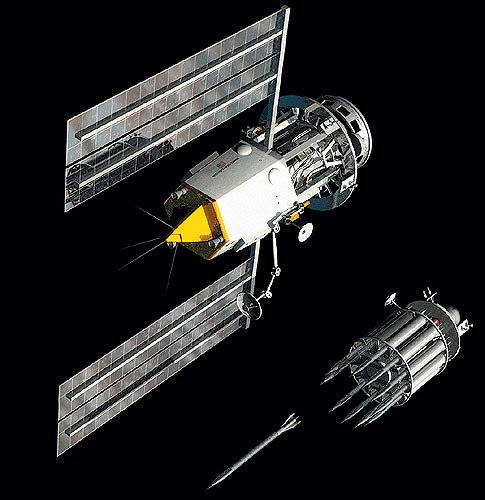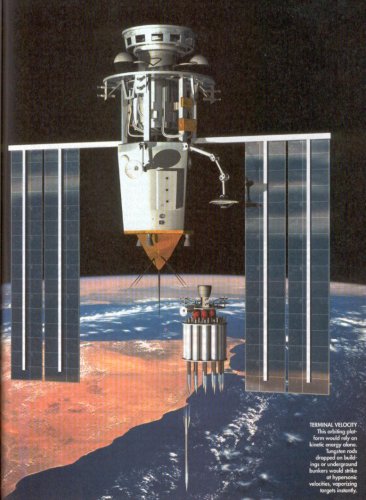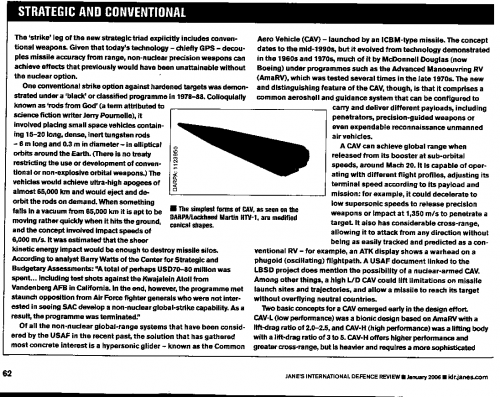A
You are using an out of date browser. It may not display this or other websites correctly.
You should upgrade or use an alternative browser.
You should upgrade or use an alternative browser.
- Joined
- 24 January 2006
- Messages
- 1,322
- Reaction score
- 470
Last I knew this was still being researched very seriously. One of the main problems was lifting the required mass into orbit. You need to have multiple Rods available so that you aren't needing a reload every 5 minutes (or being deorbited when empty and thrown away since we're retiring the primary reloader), and the tungsten rods that were being looked at were not going to be very lightweight. Plus, the issue of accuracy was being looked at. These things would be spectacular if you could get precision levels of accuracy somehow.
Lauge
ACCESS: Secret
- Joined
- 30 January 2008
- Messages
- 434
- Reaction score
- 55
As for the damage potential (from http://www.projectrho.com/rocket/rocket3x.html#kinetic):
"Rick Robinson's First Law of Space Combat states that "An object impacting at 3 km/sec delivers kinetic energy equal to its mass in TNT.""
I've always liked this concept (provided you can achieve the required pin-point accuracy). Localized damage, and it should be possible to achieve 100% deniability: "Pardon ? The building where the entire leadership cadre of the Talebananas and the Al Qaeda were in a planning session suddenly and inexplicably blew up ? Nothing to do with us, mate. We had no planes, troops, UAV's or anything like that in the area. Meteorite strike, possibly ?".
Regards & all,
Thomas L. Nielsen
Denmark
"Rick Robinson's First Law of Space Combat states that "An object impacting at 3 km/sec delivers kinetic energy equal to its mass in TNT.""
I've always liked this concept (provided you can achieve the required pin-point accuracy). Localized damage, and it should be possible to achieve 100% deniability: "Pardon ? The building where the entire leadership cadre of the Talebananas and the Al Qaeda were in a planning session suddenly and inexplicably blew up ? Nothing to do with us, mate. We had no planes, troops, UAV's or anything like that in the area. Meteorite strike, possibly ?".
Regards & all,
Thomas L. Nielsen
Denmark
A
avatar
Guest
Yup guidance and the need for a new launcher to put this at the desired altitude. That is what is probably more challenging..
The concept itself may be sound enough.
The concept itself may be sound enough.
- Joined
- 24 January 2006
- Messages
- 1,322
- Reaction score
- 470
Deniability is going to be a problem. This concept is in the public domain, and unless you go for supremely expensive full-on LO, you'll be able to track the satellite. But, being a publicly known concept, if it were to enter service, it'd be a game changer in the political landscape as far as international relations are concerned. We'll be able to thwack any place on the planet within minutes. That brings a much different type of threat to the negotiating table.
A
avatar
Guest
yeah and a non-nuclear one.
No wonder co-orbital ASAT development is continuing apace in many countries.
Soon space will mirror the cat and mouse game going on between SSNs and SSBNs in our oceans.
No wonder co-orbital ASAT development is continuing apace in many countries.
Soon space will mirror the cat and mouse game going on between SSNs and SSBNs in our oceans.
Lauge
ACCESS: Secret
- Joined
- 30 January 2008
- Messages
- 434
- Reaction score
- 55
SOC said:Deniability is going to be a problem. This concept is in the public domain, and unless you go for supremely expensive full-on LO, you'll be able to track the satellite.
Unless you cheat and put a few of these on, say, a "communications satellite" (wink-wink, nudge-nudge), instead of on a dedicated platform......
Regards & all,
Thomas L. Nielsen
Denmark
Lauge
ACCESS: Secret
- Joined
- 30 January 2008
- Messages
- 434
- Reaction score
- 55
SOC said:These things would have to be WAY bigger than your average COMSAT. Plus, somebody would notice that your heavy-lift booster was used to orbit what was supposed to be a much lighter vehicle!
..or we could use the old "two-satellites-were-on-the-booster-but-one-was-lost-when-it-separated-from-the-booster-too-late" trick.
Regards & all,
Thomas L. Nielsen
Denmark
A
avatar
Guest
This would be more like a space station. so may be 4-5 comsats huh 
Nevertheless I think the true value of this capability is in declaring it. Keeping it covert does not really do justice. Confining its use to scenarios that mainly involve taking out vermin in Afstan is not the idea I think.
Nevertheless I think the true value of this capability is in declaring it. Keeping it covert does not really do justice. Confining its use to scenarios that mainly involve taking out vermin in Afstan is not the idea I think.
- Joined
- 21 April 2009
- Messages
- 13,759
- Reaction score
- 7,700
While this system was seriously considered it became apparent that to have truly global coverage, hence, many, many satellites, that the cost would have been out of this world, pun intended!
You could do things much more cheaply, with the same precision - without raising the hackles of the NO WEAPONS IN SPACE crowd - with a conventional prompt global strike ballistic missile. While this system has "political" problems of its own its' chances for deployment are far greater than a space based system.
You could do things much more cheaply, with the same precision - without raising the hackles of the NO WEAPONS IN SPACE crowd - with a conventional prompt global strike ballistic missile. While this system has "political" problems of its own its' chances for deployment are far greater than a space based system.
Just call me Ray
ACCESS: Top Secret
- Joined
- 26 August 2007
- Messages
- 672
- Reaction score
- 55
avatar said:yeah and a non-nuclear one.
But a no-less political troubling one.
If it does massive damage and it can come out of nowhere and pretty much be interception-proof, politically, it's a nuke, radiation or no radiation.
This is definitely a strategic-scale weapon.
- Joined
- 26 September 2008
- Messages
- 1,960
- Reaction score
- 746
This was NEVER a serious research program. It has always been the kind of thing that got more attention outside of the US military than inside.
There are serious problems with it, including guidance and control, and utility--the satellite is never going to be near where it is needed when it is needed. If it takes many hours to get into range, then why not use a cruise missile?
Also, there is the danger that it can be taken over by somebody else.
There are serious problems with it, including guidance and control, and utility--the satellite is never going to be near where it is needed when it is needed. If it takes many hours to get into range, then why not use a cruise missile?
Also, there is the danger that it can be taken over by somebody else.
Comments of Dr. Jerry Pournelle concerning the Project Thor kinetic bombardment concept:
According to Dr. Pournelle, they didn't even look at Project Thor for the Strategic Defense Initiative (SDI). Unless we hear otherwise from credible sources besides Popular Science or Popular Mechanics, kinetic bombardment weapons should be considered theoretical and any artwork depicting such weapons should be considered highly speculative or in the realm of science fiction. We have no evidence that any one has looked at the concept since the 1950s besides the previously mentioned publications, science fiction authors, and computer and video games.
http://www.jerrypournelle.com/archives2/archives2mail/mail404.html#ThorAs some of you may know, I "invented" Thor a long time ago. I have no idea who decided to call it "Rods from God", but while I was in operations research back in the 1950's I developed the notion of "orbital telephone poles" made of tungsten, to be coupled with the Thoth Missile guidance systems we were developing at Boeing. Thoth was a ground control system to be used by a forward observer team. As GPS (pretty well put in place by Francis X. Kane, the "silent" co-author of Strategy of Technology, when Kane was at Systems Command) came into play, the Thor concept changed.
Space "cruisers" were part of the original High Frontier SDI concept. General Graham's team included Max Hunter, me, and a number of others. High Frontier was mostly interested in strategic defense, so my development of Thor was never part of that. It is still a useful capability that we ought to have.
According to Dr. Pournelle, they didn't even look at Project Thor for the Strategic Defense Initiative (SDI). Unless we hear otherwise from credible sources besides Popular Science or Popular Mechanics, kinetic bombardment weapons should be considered theoretical and any artwork depicting such weapons should be considered highly speculative or in the realm of science fiction. We have no evidence that any one has looked at the concept since the 1950s besides the previously mentioned publications, science fiction authors, and computer and video games.
Attachments
A
avatar
Guest
But a no-less political troubling one.
If it does massive damage and it can come out of nowhere and pretty much be interception-proof, politically, it's a nuke, radiation or no radiation.
Not as troubling as a nuke. No fall out does matter. can be used as a warfighting tool while still retaining the moral high ground, as it were. The same argument has driven the so called "pure fusion" weapons programs.
Interception proof is something that enemies may bitch about at international fora , but is sure to be lapped up by domestic constituencies in this era of ABM.
There are serious problems with it, including guidance and control,
Agreed.
the satellite is never going to be near where it is needed when it is needed. If it takes many hours to get into range, then why not use a cruise missile?
Nope. this is clearly a weapon that will be pre-positioned. And at that altitude it will cover a very wide azimuth indeed. Cruise missiles just don't cut it. They are increasingly susceptible to interception and against more meaty rivals, even the launch vector is liable to be under threat. Moreover a cruise missile may not have credible HDBT kill capability. this certainly will.
Just call me Ray
ACCESS: Top Secret
- Joined
- 26 August 2007
- Messages
- 672
- Reaction score
- 55
avatar said:But a no-less political troubling one.
If it does massive damage and it can come out of nowhere and pretty much be interception-proof, politically, it's a nuke, radiation or no radiation.
Not as troubling a nuke.
It's still a strategic weapon system hanging over an enemy's head (or it's supposed to, at least). I really don't think that would be something other nations, even a few allies, would be very comfortable with.
A
avatar
Guest
Well yes, In a way it is the grand daddy of MXs etc etc . but that's just it isn't it. the presence of this system is besides being threatening , a cool way to bargain when the new space proliferation treaty is being drafted.
- Joined
- 21 April 2009
- Messages
- 13,759
- Reaction score
- 7,700
Despite the fact that the Outer Space Treaty prohibits nuclear weapons in space - it is silent on conventional weapons - you will never get by the "no weapons in space" protests as I mentioned before. Again, it is much cheaper to base five or so Minatour IV conventional ICBMs at Vandenberg (I would develop a super heavy lift ICBM that could carry Ares I sized payloads). Rods from God - I like Thor better - cannot match the combination of capabilities listed below. Conventional ICBMs are;
1) safe and secure
2) cheap - relatively speaking
3) known technological capabilities
4) deployable within a decade or less
5) can be fully tested from existing facilities
1) safe and secure
2) cheap - relatively speaking
3) known technological capabilities
4) deployable within a decade or less
5) can be fully tested from existing facilities
A
avatar
Guest
And a conventional ICBM will never get by the :
" OMG This will be mistaken for a strategic launch" kind of protest , regardless of what safeguards and discriminants anybody comes up with.
This will be mistaken for a strategic launch" kind of protest , regardless of what safeguards and discriminants anybody comes up with.
There was an excellent CRS paper on how to deploy CICBMs to avoid the confusion, but I am sure that will not cut ice with those who are worried by anything resembling a conventional strategic capability.
On the other hand , space is already being weaponized, for ABM etc etc. It is only a matter of time. only a matter of time.
" OMG
There was an excellent CRS paper on how to deploy CICBMs to avoid the confusion, but I am sure that will not cut ice with those who are worried by anything resembling a conventional strategic capability.
On the other hand , space is already being weaponized, for ABM etc etc. It is only a matter of time. only a matter of time.
- Joined
- 26 September 2008
- Messages
- 1,960
- Reaction score
- 746
>>the satellite is never going to be near where it is needed when it is needed. If it takes many hours to get into range, then why not use a cruise missile?
Nope. this is clearly a weapon that will be pre-positioned. And at that altitude it will cover a very wide azimuth indeed. Cruise missiles just don't cut it. They are increasingly susceptible to interception and against more meaty rivals, even the launch vector is liable to be under threat. Moreover a cruise missile may not have credible HDBT kill capability. this certainly will.
Can you explain how a weapon is "pre-positioned" in space?
blackstar said:>>the satellite is never going to be near where it is needed when it is needed. If it takes many hours to get into range, then why not use a cruise missile?
Nope. this is clearly a weapon that will be pre-positioned. And at that altitude it will cover a very wide azimuth indeed. Cruise missiles just don't cut it. They are increasingly susceptible to interception and against more meaty rivals, even the launch vector is liable to be under threat. Moreover a cruise missile may not have credible HDBT kill capability. this certainly will.
Can you explain how a weapon is "pre-positioned" in space?
1) Geosynchronous (makes it hard for a tactical fast-response system, however)
2) Lunar basing (even harder for a tactical system)
3) Antigravity hovering (slight technical hitch with that)
Space based weapons *do* have all kinds of advantages and capabilities. But unless you have a *lot* of weapons in space, getting them onto surface targets when *you* don't get to choose the timing is a bitch. Especially if the enemy can track your weapons and adjust *their* schedule accordingly
A
avatar
Guest
But unless you have a *lot* of weapons in space, getting them onto surface targets when *you* don't get to choose the timing is a bitch. Especially if the enemy can track your weapons and adjust *their* schedule accordingly
Yeah. but this system isn't really meant for any targets with re-locational capability. it is meant to threaten HDBTs like underground facilities carrying out "crown jewel" research and storage facilities for submarines etc. yeah submarines can run away but the opponent will lose something he has invested tons of precious moolah in.
In any case having more would obviously give flexibility.
- Joined
- 26 September 2008
- Messages
- 1,960
- Reaction score
- 746
avatar said:Yeah. but this system isn't really meant for any targets with re-locational capability. it is meant to threaten HDBTs like underground facilities carrying out "crown jewel" research and storage facilities for submarines etc. yeah submarines can run away but the opponent will lose something he has invested tons of precious moolah in.
In any case having more would obviously give flexibility.
Can you provide any cites for this program? Any proof that it is intended to do what you say it is?
avatar said:Yeah. but this system isn't really meant for any targets with re-locational capability. it is meant to threaten HDBTs like underground facilities carrying out "crown jewel" research and storage facilities for submarines etc.
That would be a pointless use of the system. Space based ground penetrators using nothing but kinetic energy weapons would not add much to what can be done with more conventional penetrators... and could potentially perform *worse* and at much greater cost. Just as subsonic bullets and shotgun slugs go further in water than supersonic rounds, a mach-17 penetrator is very likely to be simply vaporized very shortly after impact. While this will result in an impressive *bang* on the surface it won't do diddly-squat for deeply buried bunkers.
If you want to take out a deeply buried structure, you either use a more conventional penetrator with a nuclear warhead, or somethign like DARPA's "Deep Digger."
Project Thor would be more appropriately used on high value surface targets like ships and buildings, targets that could potentially defend themselves against more conventional attack.
A
avatar
Guest
a mach-17 penetrator is very likely to be simply vaporized very shortly after impact. While this will result in an impressive *bang* on the surface it won't do diddly-squat for deeply buried bunkers.
that bang has to be directed, even the case of a nuclear explosion to have the desired effect. that is one of the 'engineering' challenges of this project, isn't it?
A rod shaped re-entry vehicle would be designed to cause cylindrical impact and will try to reach the atmosphere of the buried target where the hot tungsten gas will act as a shaped charge.
Apparently for every 1.0 m of the tungsten rod 1.5 m of steel target can be done in.
Similar threads
-
-
-
-
King Lugwig II's Flying Machines
- Started by amsci99
- Replies: 0
-
Early Developments Of Solid Rockets Fired From Aircraft
- Started by Stargazer
- Replies: 8




